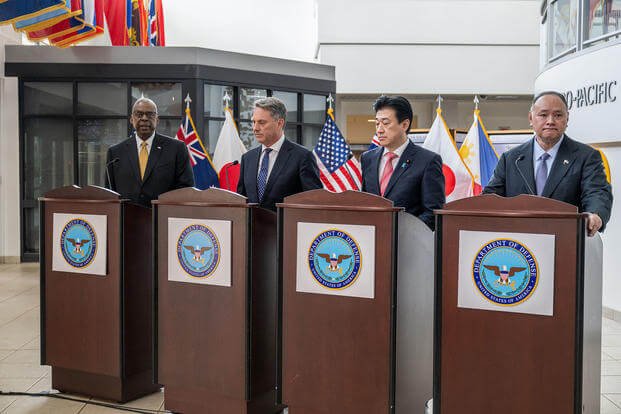HONOLULU -- Amid a gathering of top defense leaders from across the Pacific in Hawaii, Pentagon officials said Thursday that the U.S. not only needs to grow its ties in the region but also bolster the number of troops there to deter China.
Defense Secretary Lloyd Austin, while standing alongside his counterparts from Australia, Japan and the Philippines, said that the four leaders "discussed how we can deepen our trilateral cooperation to strengthen stability and security."
However, one military official also said that the U.S. needs "an improved force posture and it needs to be west of the International Date Line ... so that we can have a lethal and combat credible force" closer to China, Russia and North Korea.
Read Next: Temporary Promotions for Army Noncommissioned Officers to End in June
Austin's day of meetings with his counterparts in the region comes as China continues to expand its campaign of harassing and threatening nearby countries and their ships in the South China Sea.
On Tuesday, the Philippine coast guard announced that two of its ships were rammed and shot with water cannons by vessels from the Chinese coast guard. The incident is just the latest in a growing number of skirmishes that are only increasing in frequency.
Defense officials at the Pentagon told reporters that incidents like this are "really worrisome operational behavior and coercion" and "a topic that we're going to focus on together."
Earlier in April, Austin assured Philippine President Ferdinand Marcos Jr. that the long-standing mutual defense treaty "extends to both countries' armed forces, public vessels, and aircraft -- including those of its coast guard -- anywhere in the Pacific, including the South China Sea," according to Pentagon spokesman Maj. Gen. Pat Ryder.
However, Gilberto Teodoro Jr., the Philippine defense secretary, told reporters that he didn't want to discuss "a scenario when or in what occasions the [defense treaty] may be invoked,” before noting that its invocation "will be a political decision, at the end of the day."
But as incidents between China and the Philippines continue to simmer, the U.S. military official said there is a worry that there aren't enough U.S. service members in the region to respond to a possible, future incident or offer "a lethal and combat credible force forward."
The military official noted to reporters that, while the Indo-Pacific has about 300,000 assigned forces, only about 80,000 of those are west of the International Date Line, which passes through the center of the Pacific, and the bulk of those are in Japan.
However, simply moving troops into the region permanently is not on the table since there are both legal and political constraints.
In February, the Philippines agreed to increase the number of military camps that the U.S. will be allowed to maintain in the country to nine. However, those are not bases with permanently stationed troops but rather locations that the U.S. military has access to should it need them.
Meanwhile, Australia recently inked a historic deal, commonly called "AUKUS," that will see the U.S. provide the island nation with its much-coveted, nuclear-powered submarine technology. However, the military official noted that "Australia's constitution prevents us basing in Australia."
The solution, officials say, is to continue to build relationships with allies and increase the tempo of exercises and troop rotations through the region.
Austin said that he and the other leaders are "looking to conduct more maritime exercises and activities among our four countries," while officials at the Pentagon said that the aim for the meetings was to generate "'no kidding' proposals for collective action."
"We need to create opportunities for training environments, for locations that they can do rotational visits to," the military official said.
Austin acknowledged that "we're clear-eyed about the challenges that exist throughout the region and so we'll need to continue to work together."
"But that's why we're here -- because we share a common vision," Austin said.












